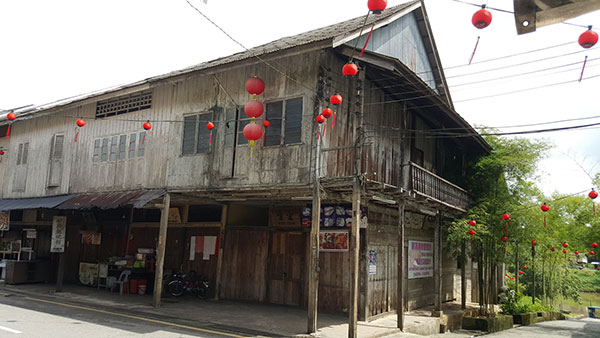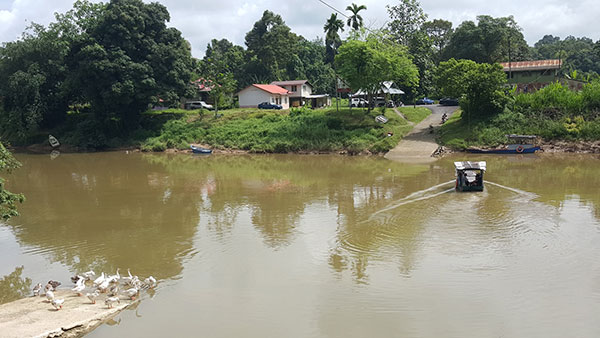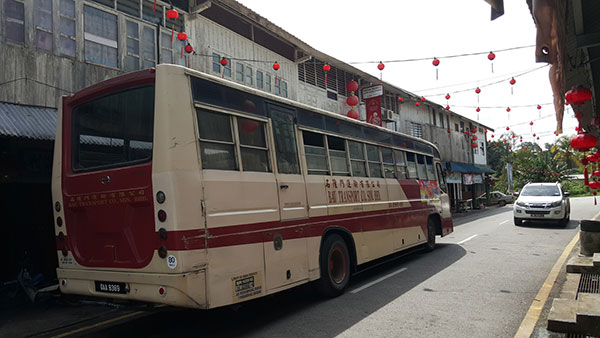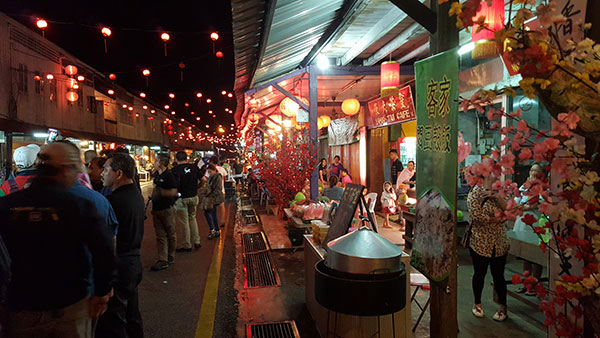
A section of the old wooden buildings.
SOME small towns or bazaars are dosy while others are swanky, artsy and even cool.
There is also one that is unique where the shops are original and the smiles genuine. Known as Siniawan Bazaar, it is located along Bau Road, about 26km from Kuching, and was once a two-row trading-cum-residential sleepy hollow where travellers stopped by for light refreshments or to shop for curios or antiques on their way upcountry.
Siniawan is an example of the early Sarawak towns where time seems to have stood still. It’s worthwhile exploring the bazaar because you may come across some very interesting items that cannot be found in the bigger towns and cities.
I did not have the opportunity to go into any of the antiquated shophouses but from the looks of their structures, buildings made of good wood are apparently able to last at least a few hundred years — far longer than we may actually need the buildings.
While wood does not have the historical longevity of stone, the old wooden buildings at Siniawan Bazaar, nonetheless, remain standing to this very day.
In Sarawak, wood has long been a dominant building material. Most of the ancient wooden buildings are long gone — lost to fire, decay or torn down.
However, there are still many wooden heritage buildings in Kuching, probably constructed in the 18th and 19th centuries.
Their exterior claddings may have been replaced but the structural wood is original.
If you like old wooden architecture, Siniawan Bazaar is one place to visit and see as most of the structures and designs of the buildings remain untouched.

The Siniawan jetty.
Just two shop rows
Siniawan is actually a street flanked by two rows of 24 wooden shophouses each on either side. The buildings are all made of wood like most in a bygone era of the state.
I still remember in the early 1980’s I used to travel by bus to visit my brother-in-law in Siniawan. Back then, the bazaar was a very quiet place — reminiscent of a typical Wild West cowboy town with a single street where the inhabitants lazed about the corridors to watch the world go by.
Even though there is only a narrow street through the heart of the bazaar, travellers along Bau Road in the old days liked to stop by for a drink or even a meal – plus the oft-chance to shop for some collector’s items.
Siniawan was once a bustling Chinese enclave but constant flooding forced most of its residents to move to higher areas. Before the Kuching-Bau bypass was built, motorists had to pass through Siniawan’s only street and if a bus dropped passengers at the bazaar, other vehicles had to queue behind it on the tight single lane road.
Ironically, the road bypass turned Siniawan into a ghost town as many businesses there had to close down. However, in recent years, efforts had been made to breathe new life into the place through the revival of traditions and cultures.
The latest innovation is the popular night market which provides a welcome getaway from urban hurly-burly for weekenders and out-of-towners.
However, even improvements such as the night market and the concomitant droves of visitors, most, if not all, of the buildings still retain their original structures — with only minimum modifications to some of them. Ever since the night market began operating, most of the thrift shops have been turned into coffeeshops.

Bau Transport Company bus passes through the narrow Siniawan street.
Vibrant place
The joint efforts of the Kapitan and the residents have transformed Siniawan into a vibrant place during weekend nights.
Looks can, indeed, be deceiving for while Siniawan appears pretty much a snoozer by day, it pulsates with life after dusk — thanks to the night market. And despite the new lease on life, the bazaar still has a charmingly idyllic feel about it.
It is brought to life every Friday and Saturday evening from 6.30pm to 10pm. The night market has become a favourite social rendezvous spot for most locals who may have to come as early as 5.30pm to get a parking space.
There is plenty of food to choose from, including an assortment of non-halal hawker fare. The stalls are lined along the whole stretch of the street with dining tables spread out on it when the weather is fine.
Apart from Chinese cuisine, Malay and local traditional food such as snacks, cakes and savouries are also available. Prices are generally reasonable. Events like cultural performances, karaoke and a mix of traditional and modern musical shows are held from time to time.
Festival-like atmosphere
The atmosphere at the night market is festive. Music emanates from the middle of the street where a special stage is designated for KTV (Karaoke TV) revellers to entertain the public with a song or two as the latter dine and enjoy the good food.
The Siniawan night market is also known for the classic designs and the beautiful decorations of its shophouses.
My first time there was during an election campaign. The atmosphere was really amazing — brightly lit with beautiful red lanterns strung across the street from one end to the other end.
It made you feel like walking under a thousand stars. So it’s no surprise that both visitors and
local residents alike are making a beeline to the Siniawan night market. Truly, this rustic upcountry bazaar is a sleepy hollow that awakens from its slumber at night.
Some say it’s a quiet little place that has been transformed into a lively night market for food hunters. It’s a fantastic place to chill out and spend the evening soaking up the energised atmosphere.
The old wooden shophouses tell their own good stories. Spending some time at the bazaar during the day gives one an insight into life at a heritage town that is more than a century old.
Populated mostly by the Hakkas, Siniawan is a small town that nearly slipped into oblivion at one time but has rebounded on the back continual renewal efforts. Eye-catching timber frontages now adorn top floors of its two-storey buildings.

Siniawan comes alive at night.
Hakka Heritage Bazaar
Newly-elected Serembu assemblyman Miro Simuh, who believes Siniawan has great potential to prosper into a sought after tourist destination in his constituency, is planning to transform the place into the Hakka Heritage Bazaar.
He said a proposal was recently submitted to Tourism Minister Datuk Seri Mohamed Nazri Aziz.
Miro revealed the project components would include replacing some of the run-down wooden walls and windows of the buildings, provision of public toilets, construction of an amphitheatre near the Tua Pek Kong temple at the riverfront and landscaping along the small junction to the jetty.
“We want to retain the wooden structures and make the surroundings beautiful and unique. I have submitted an RM3 million proposal to the minister personally and if approved, the allocation will be channelled through the state’s Tourism Ministry,” he said.
According to Miro, it has also been decided to hold Pesta Siniawan annually from Sept 15 – 18 in conjunction with the Lantern Festival. The Tourism Minister wants the Pesta to be an annual event so that he can allocate a budget for it.
Miro said the transformation of Siniawan was one of his tourism development plans for Serembu, adding that the Brooke heritage site in Peninjau, Kampung Tringus and Bengoh Range would also be transmuted into eco-tourism products.
Historical evidence has it that Siniawan used to cater to gold prospectors from nearby Bau. The bazaar was established long before the white Rajah James Brooke set foot in the state.
The old Siniawan town was set up by the Chinese from Bau in 1821. After fleeing Brooke’s raid on the goldmining enclave, they eventually settled in Siniawan.
The Chinese had rebelled against Brooke for imposing taxes, prohibiting direct trading of opium and wine with foreign countries and banning direct exports of gold and antimony.
Siniawan saw further upheavals through the Japanese occupation, the Malaysia-Indonesia Confrontation and the communist insurgency.
Built in the mid-19th century, the wooden architecture of the shophouses is unique and has attracted shutterbugs from near and far.
Although the place had gone through the rule of the Brookes, the Japanese and the British, its facade has not changed one bit.
According to the residents, most of the shophouses still standing are the same as before. Some of the shopowners have used cement to make minor alterations to the wooden walls and posts but the original exterior designs are still maintained.
At night on weekends, the street comes alive. Lanterns are lit while hawker stalls set up by the roadside. Tables and chairs are placed along the street as visitors from the city start coming in for a night out in a convivial setting.

Miro (standing second left) and Nazri (standing right) chat with diners during their walkabout at the Siniawan night market.
